Identity Based Conflicts | Report
VerifiedAdded on 2022/08/20
|11
|2534
|14
AI Summary
Contribute Materials
Your contribution can guide someone’s learning journey. Share your
documents today.
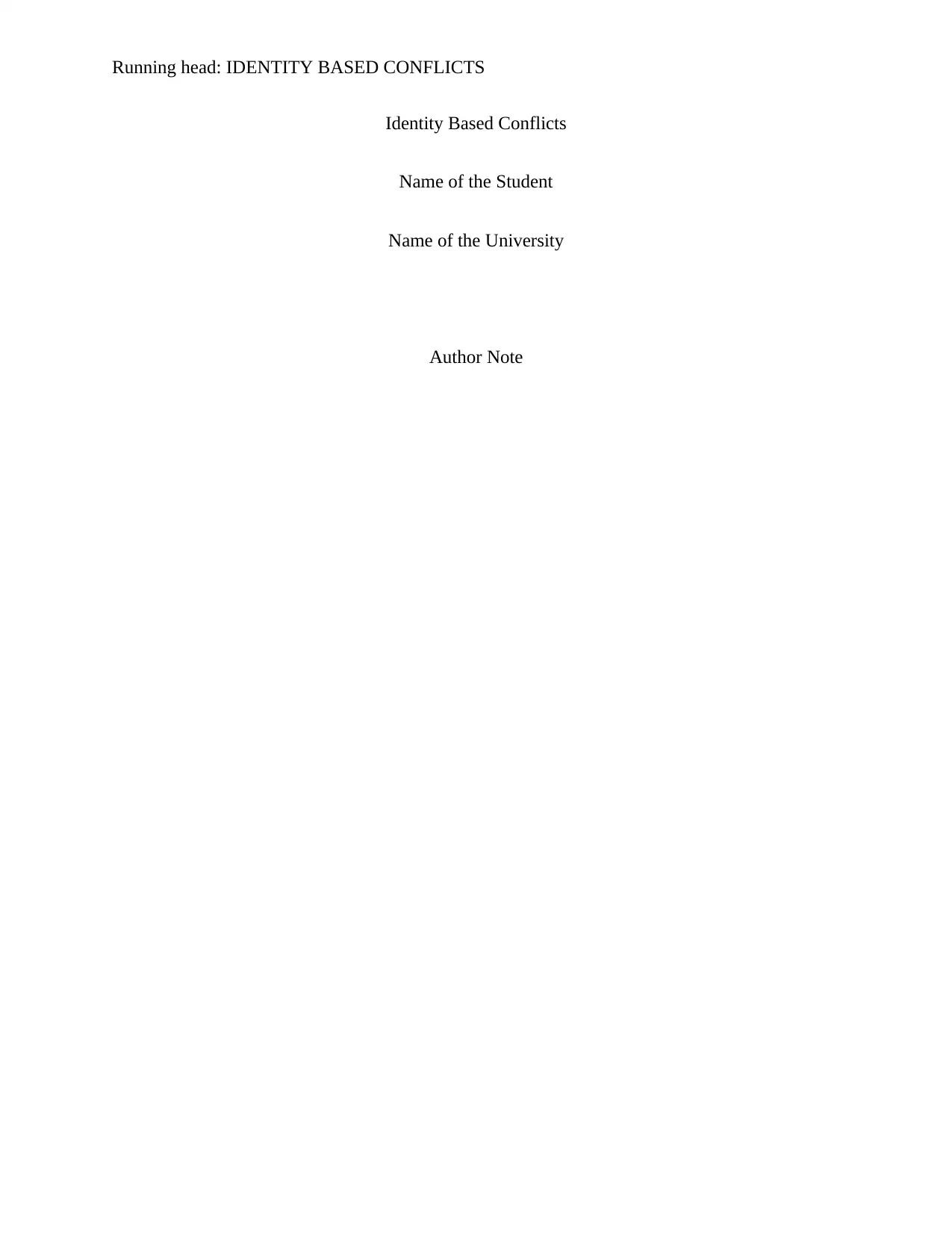
Running head: IDENTITY BASED CONFLICTS
Identity Based Conflicts
Name of the Student
Name of the University
Author Note
Identity Based Conflicts
Name of the Student
Name of the University
Author Note
Secure Best Marks with AI Grader
Need help grading? Try our AI Grader for instant feedback on your assignments.
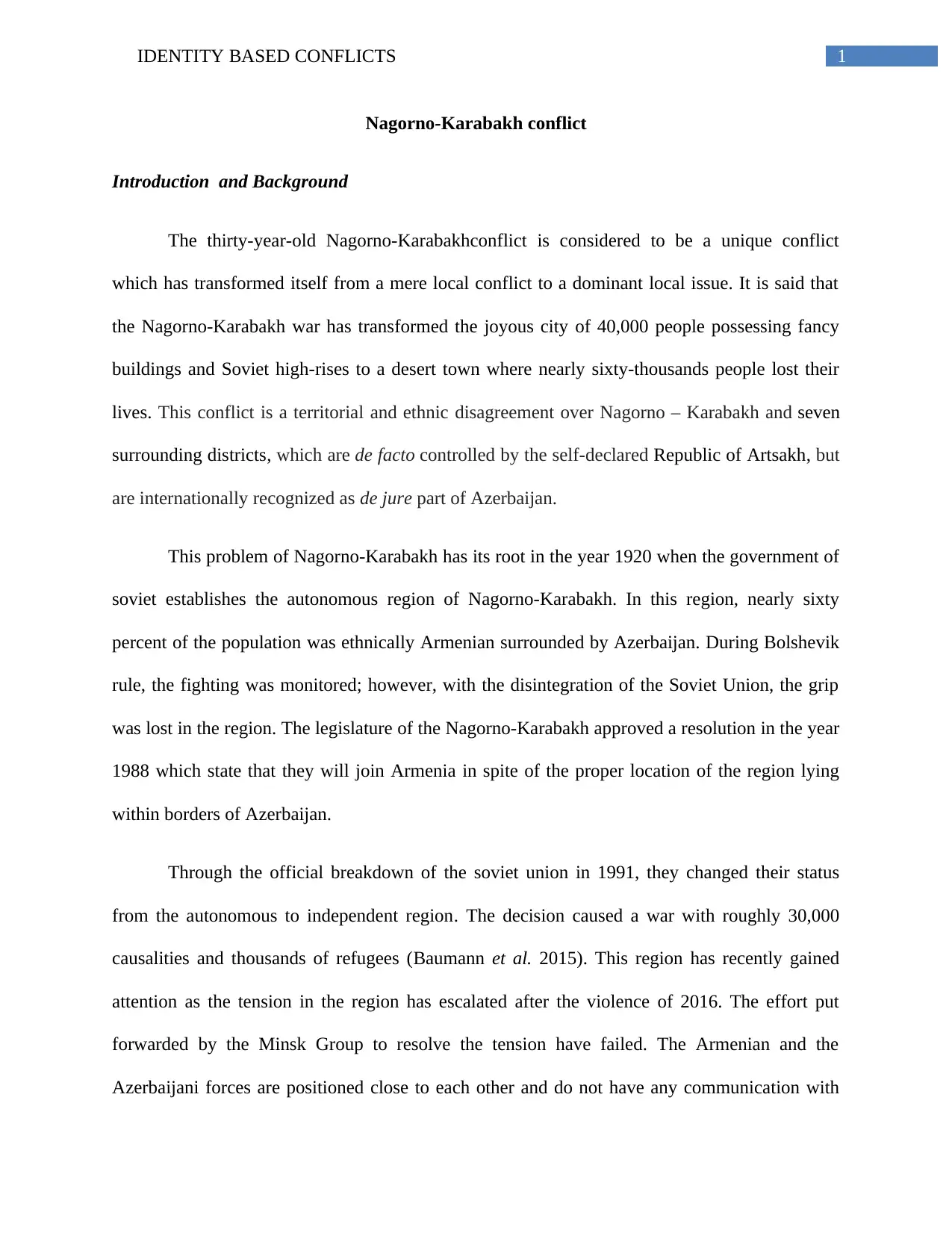
1IDENTITY BASED CONFLICTS
Nagorno-Karabakh conflict
Introduction and Background
The thirty-year-old Nagorno-Karabakhconflict is considered to be a unique conflict
which has transformed itself from a mere local conflict to a dominant local issue. It is said that
the Nagorno-Karabakh war has transformed the joyous city of 40,000 people possessing fancy
buildings and Soviet high-rises to a desert town where nearly sixty-thousands people lost their
lives. This conflict is a territorial and ethnic disagreement over Nagorno – Karabakh and seven
surrounding districts, which are de facto controlled by the self-declared Republic of Artsakh, but
are internationally recognized as de jure part of Azerbaijan.
This problem of Nagorno-Karabakh has its root in the year 1920 when the government of
soviet establishes the autonomous region of Nagorno-Karabakh. In this region, nearly sixty
percent of the population was ethnically Armenian surrounded by Azerbaijan. During Bolshevik
rule, the fighting was monitored; however, with the disintegration of the Soviet Union, the grip
was lost in the region. The legislature of the Nagorno-Karabakh approved a resolution in the year
1988 which state that they will join Armenia in spite of the proper location of the region lying
within borders of Azerbaijan.
Through the official breakdown of the soviet union in 1991, they changed their status
from the autonomous to independent region. The decision caused a war with roughly 30,000
causalities and thousands of refugees (Baumann et al. 2015). This region has recently gained
attention as the tension in the region has escalated after the violence of 2016. The effort put
forwarded by the Minsk Group to resolve the tension have failed. The Armenian and the
Azerbaijani forces are positioned close to each other and do not have any communication with
Nagorno-Karabakh conflict
Introduction and Background
The thirty-year-old Nagorno-Karabakhconflict is considered to be a unique conflict
which has transformed itself from a mere local conflict to a dominant local issue. It is said that
the Nagorno-Karabakh war has transformed the joyous city of 40,000 people possessing fancy
buildings and Soviet high-rises to a desert town where nearly sixty-thousands people lost their
lives. This conflict is a territorial and ethnic disagreement over Nagorno – Karabakh and seven
surrounding districts, which are de facto controlled by the self-declared Republic of Artsakh, but
are internationally recognized as de jure part of Azerbaijan.
This problem of Nagorno-Karabakh has its root in the year 1920 when the government of
soviet establishes the autonomous region of Nagorno-Karabakh. In this region, nearly sixty
percent of the population was ethnically Armenian surrounded by Azerbaijan. During Bolshevik
rule, the fighting was monitored; however, with the disintegration of the Soviet Union, the grip
was lost in the region. The legislature of the Nagorno-Karabakh approved a resolution in the year
1988 which state that they will join Armenia in spite of the proper location of the region lying
within borders of Azerbaijan.
Through the official breakdown of the soviet union in 1991, they changed their status
from the autonomous to independent region. The decision caused a war with roughly 30,000
causalities and thousands of refugees (Baumann et al. 2015). This region has recently gained
attention as the tension in the region has escalated after the violence of 2016. The effort put
forwarded by the Minsk Group to resolve the tension have failed. The Armenian and the
Azerbaijani forces are positioned close to each other and do not have any communication with
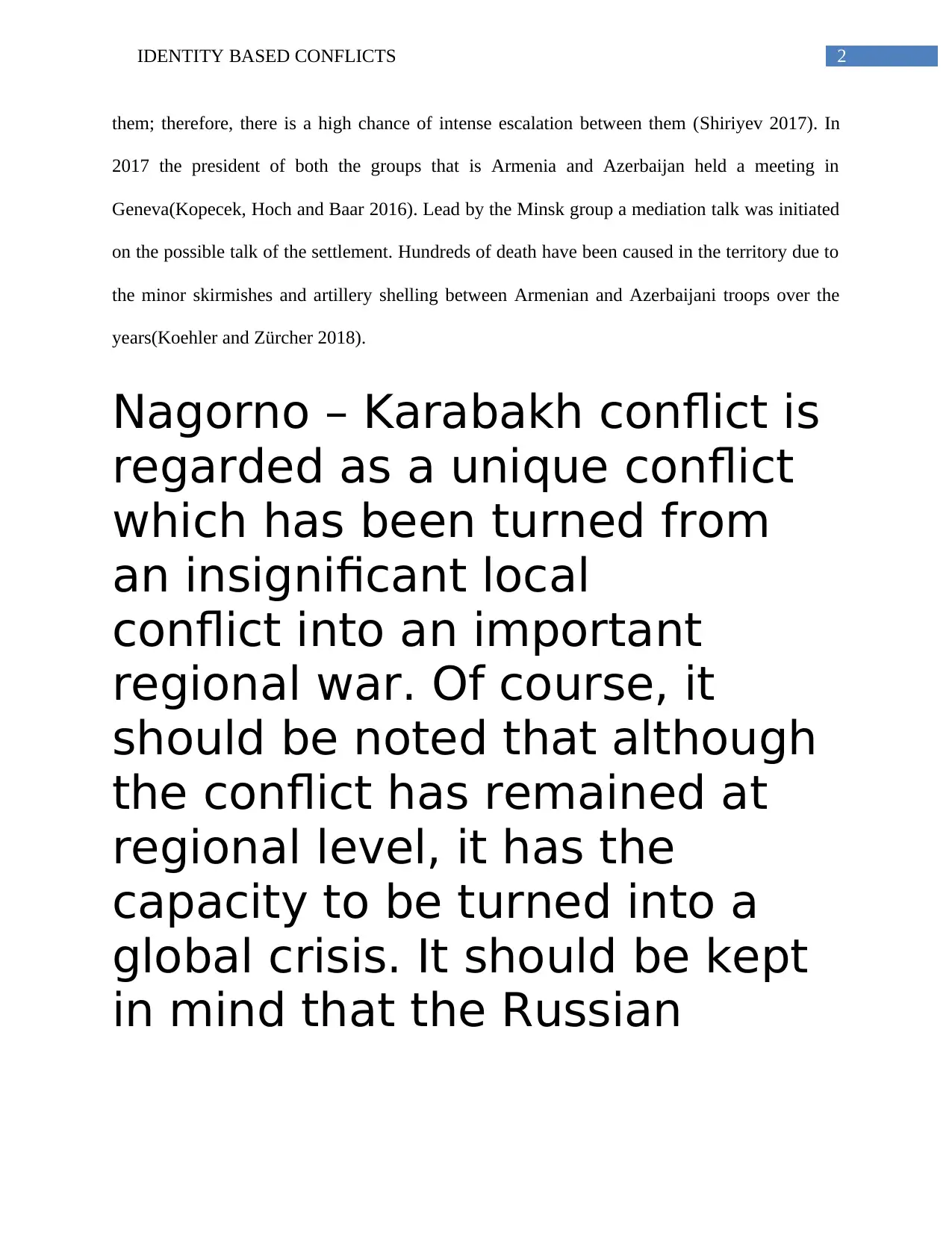
2IDENTITY BASED CONFLICTS
them; therefore, there is a high chance of intense escalation between them (Shiriyev 2017). In
2017 the president of both the groups that is Armenia and Azerbaijan held a meeting in
Geneva(Kopecek, Hoch and Baar 2016). Lead by the Minsk group a mediation talk was initiated
on the possible talk of the settlement. Hundreds of death have been caused in the territory due to
the minor skirmishes and artillery shelling between Armenian and Azerbaijani troops over the
years(Koehler and Zürcher 2018).
Nagorno – Karabakh conflict is
regarded as a unique conflict
which has been turned from
an insignificant local
conflict into an important
regional war. Of course, it
should be noted that although
the conflict has remained at
regional level, it has the
capacity to be turned into a
global crisis. It should be kept
in mind that the Russian
them; therefore, there is a high chance of intense escalation between them (Shiriyev 2017). In
2017 the president of both the groups that is Armenia and Azerbaijan held a meeting in
Geneva(Kopecek, Hoch and Baar 2016). Lead by the Minsk group a mediation talk was initiated
on the possible talk of the settlement. Hundreds of death have been caused in the territory due to
the minor skirmishes and artillery shelling between Armenian and Azerbaijani troops over the
years(Koehler and Zürcher 2018).
Nagorno – Karabakh conflict is
regarded as a unique conflict
which has been turned from
an insignificant local
conflict into an important
regional war. Of course, it
should be noted that although
the conflict has remained at
regional level, it has the
capacity to be turned into a
global crisis. It should be kept
in mind that the Russian
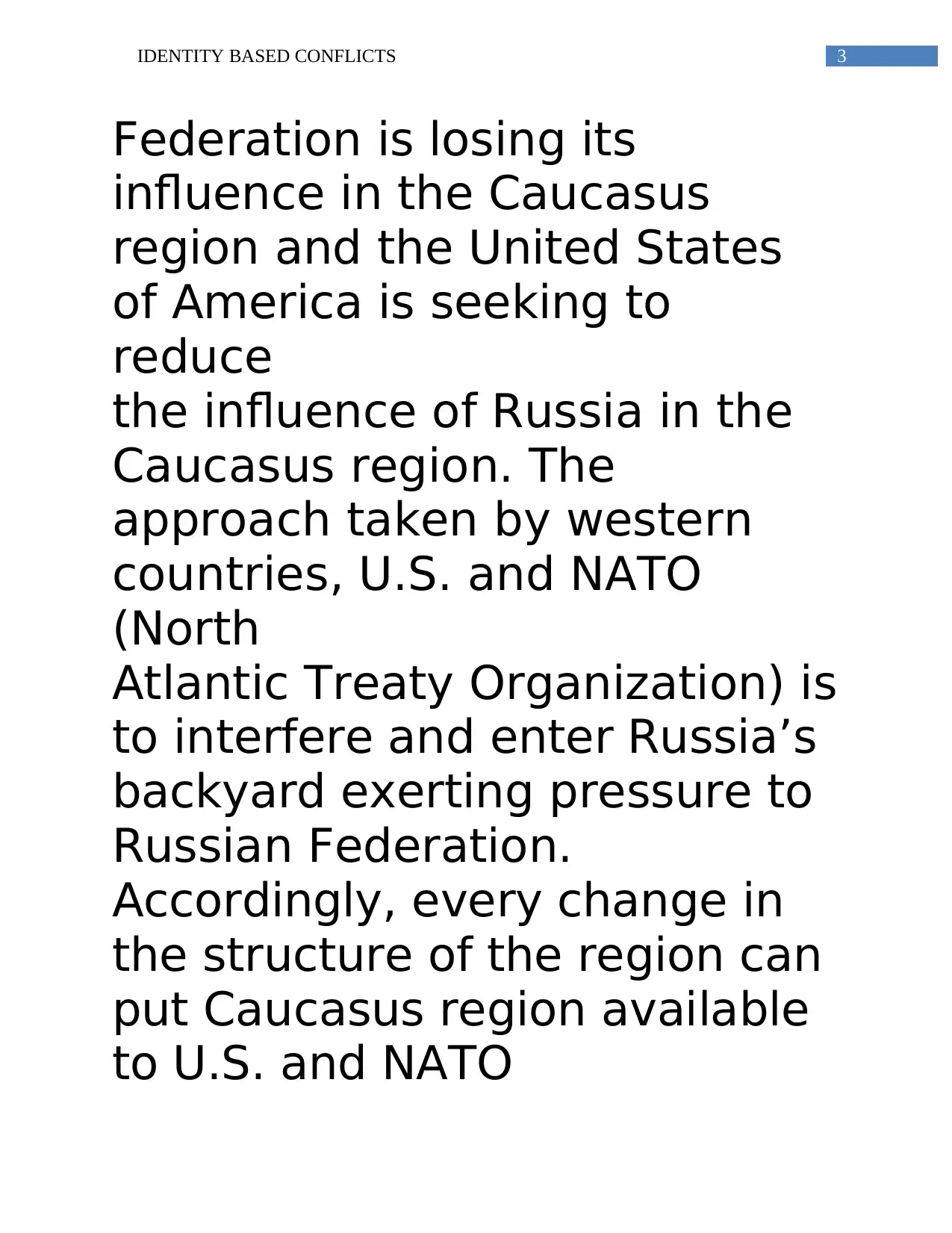
3IDENTITY BASED CONFLICTS
Federation is losing its
influence in the Caucasus
region and the United States
of America is seeking to
reduce
the influence of Russia in the
Caucasus region. The
approach taken by western
countries, U.S. and NATO
(North
Atlantic Treaty Organization) is
to interfere and enter Russia’s
backyard exerting pressure to
Russian Federation.
Accordingly, every change in
the structure of the region can
put Caucasus region available
to U.S. and NATO
Federation is losing its
influence in the Caucasus
region and the United States
of America is seeking to
reduce
the influence of Russia in the
Caucasus region. The
approach taken by western
countries, U.S. and NATO
(North
Atlantic Treaty Organization) is
to interfere and enter Russia’s
backyard exerting pressure to
Russian Federation.
Accordingly, every change in
the structure of the region can
put Caucasus region available
to U.S. and NATO
Secure Best Marks with AI Grader
Need help grading? Try our AI Grader for instant feedback on your assignments.
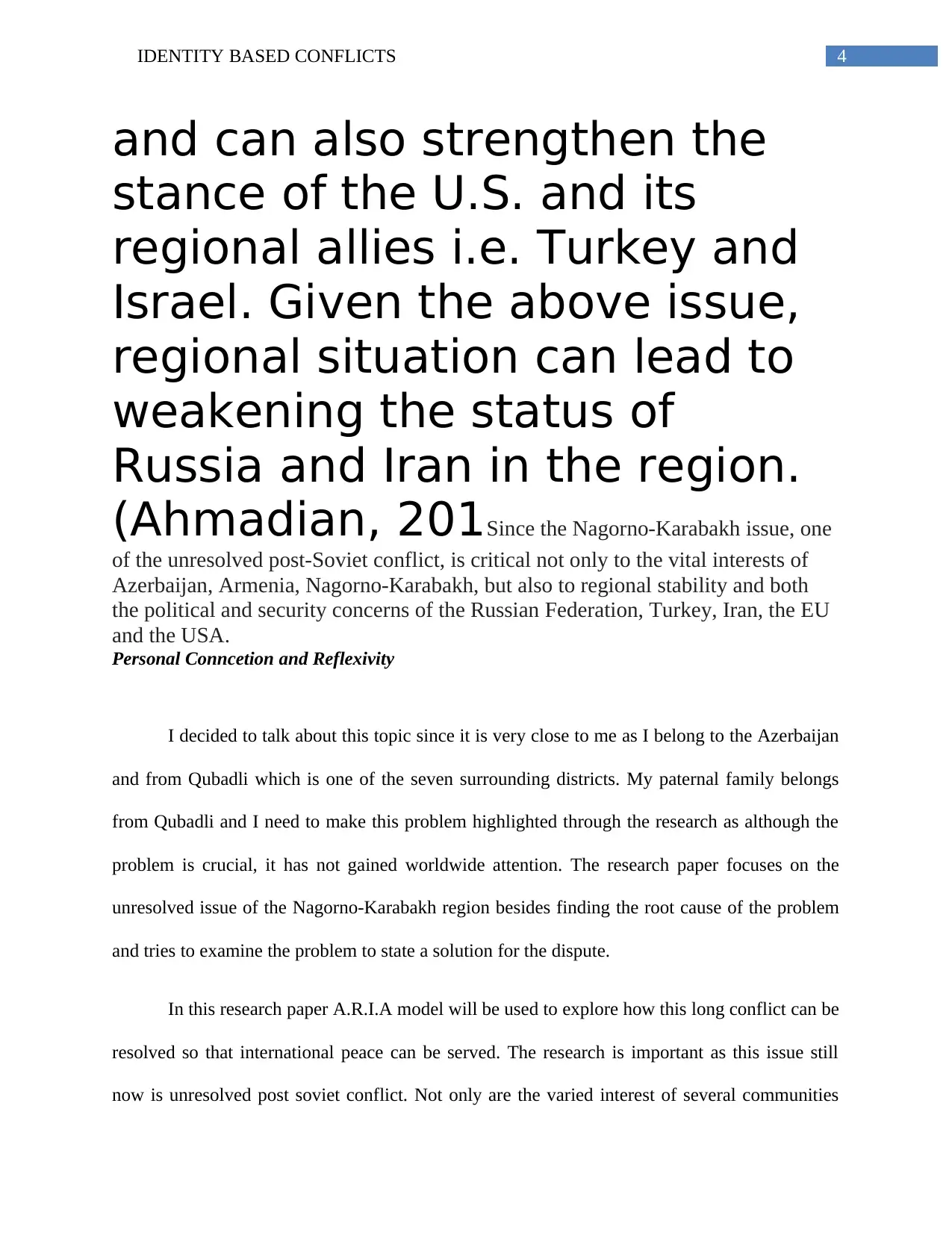
4IDENTITY BASED CONFLICTS
and can also strengthen the
stance of the U.S. and its
regional allies i.e. Turkey and
Israel. Given the above issue,
regional situation can lead to
weakening the status of
Russia and Iran in the region.
(Ahmadian, 201Since the Nagorno-Karabakh issue, one
of the unresolved post-Soviet conflict, is critical not only to the vital interests of
Azerbaijan, Armenia, Nagorno-Karabakh, but also to regional stability and both
the political and security concerns of the Russian Federation, Turkey, Iran, the EU
and the USA.
Personal Conncetion and Reflexivity
I decided to talk about this topic since it is very close to me as I belong to the Azerbaijan
and from Qubadli which is one of the seven surrounding districts. My paternal family belongs
from Qubadli and I need to make this problem highlighted through the research as although the
problem is crucial, it has not gained worldwide attention. The research paper focuses on the
unresolved issue of the Nagorno-Karabakh region besides finding the root cause of the problem
and tries to examine the problem to state a solution for the dispute.
In this research paper A.R.I.A model will be used to explore how this long conflict can be
resolved so that international peace can be served. The research is important as this issue still
now is unresolved post soviet conflict. Not only are the varied interest of several communities
and can also strengthen the
stance of the U.S. and its
regional allies i.e. Turkey and
Israel. Given the above issue,
regional situation can lead to
weakening the status of
Russia and Iran in the region.
(Ahmadian, 201Since the Nagorno-Karabakh issue, one
of the unresolved post-Soviet conflict, is critical not only to the vital interests of
Azerbaijan, Armenia, Nagorno-Karabakh, but also to regional stability and both
the political and security concerns of the Russian Federation, Turkey, Iran, the EU
and the USA.
Personal Conncetion and Reflexivity
I decided to talk about this topic since it is very close to me as I belong to the Azerbaijan
and from Qubadli which is one of the seven surrounding districts. My paternal family belongs
from Qubadli and I need to make this problem highlighted through the research as although the
problem is crucial, it has not gained worldwide attention. The research paper focuses on the
unresolved issue of the Nagorno-Karabakh region besides finding the root cause of the problem
and tries to examine the problem to state a solution for the dispute.
In this research paper A.R.I.A model will be used to explore how this long conflict can be
resolved so that international peace can be served. The research is important as this issue still
now is unresolved post soviet conflict. Not only are the varied interest of several communities
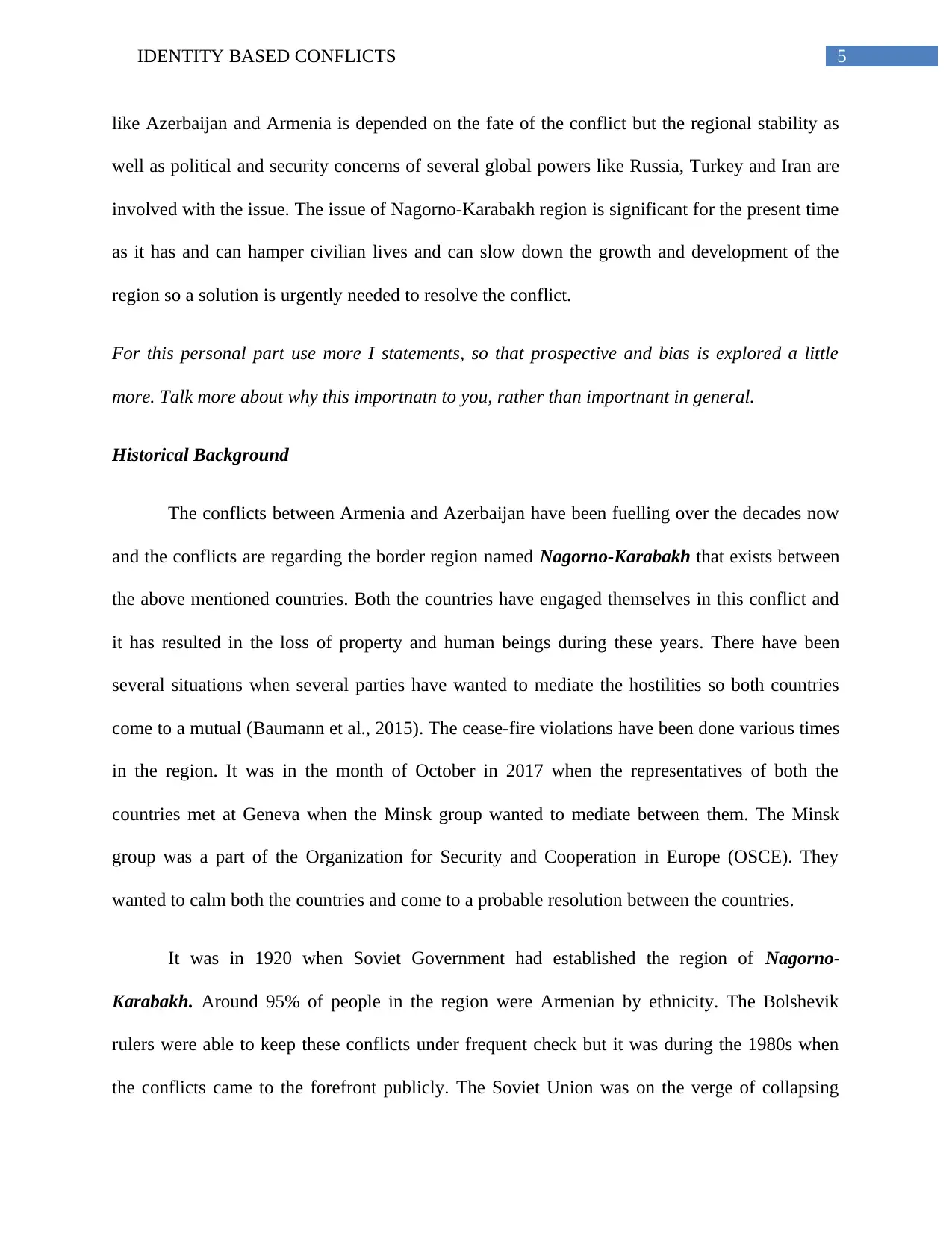
5IDENTITY BASED CONFLICTS
like Azerbaijan and Armenia is depended on the fate of the conflict but the regional stability as
well as political and security concerns of several global powers like Russia, Turkey and Iran are
involved with the issue. The issue of Nagorno-Karabakh region is significant for the present time
as it has and can hamper civilian lives and can slow down the growth and development of the
region so a solution is urgently needed to resolve the conflict.
For this personal part use more I statements, so that prospective and bias is explored a little
more. Talk more about why this importnatn to you, rather than importnant in general.
Historical Background
The conflicts between Armenia and Azerbaijan have been fuelling over the decades now
and the conflicts are regarding the border region named Nagorno-Karabakh that exists between
the above mentioned countries. Both the countries have engaged themselves in this conflict and
it has resulted in the loss of property and human beings during these years. There have been
several situations when several parties have wanted to mediate the hostilities so both countries
come to a mutual (Baumann et al., 2015). The cease-fire violations have been done various times
in the region. It was in the month of October in 2017 when the representatives of both the
countries met at Geneva when the Minsk group wanted to mediate between them. The Minsk
group was a part of the Organization for Security and Cooperation in Europe (OSCE). They
wanted to calm both the countries and come to a probable resolution between the countries.
It was in 1920 when Soviet Government had established the region of Nagorno-
Karabakh. Around 95% of people in the region were Armenian by ethnicity. The Bolshevik
rulers were able to keep these conflicts under frequent check but it was during the 1980s when
the conflicts came to the forefront publicly. The Soviet Union was on the verge of collapsing
like Azerbaijan and Armenia is depended on the fate of the conflict but the regional stability as
well as political and security concerns of several global powers like Russia, Turkey and Iran are
involved with the issue. The issue of Nagorno-Karabakh region is significant for the present time
as it has and can hamper civilian lives and can slow down the growth and development of the
region so a solution is urgently needed to resolve the conflict.
For this personal part use more I statements, so that prospective and bias is explored a little
more. Talk more about why this importnatn to you, rather than importnant in general.
Historical Background
The conflicts between Armenia and Azerbaijan have been fuelling over the decades now
and the conflicts are regarding the border region named Nagorno-Karabakh that exists between
the above mentioned countries. Both the countries have engaged themselves in this conflict and
it has resulted in the loss of property and human beings during these years. There have been
several situations when several parties have wanted to mediate the hostilities so both countries
come to a mutual (Baumann et al., 2015). The cease-fire violations have been done various times
in the region. It was in the month of October in 2017 when the representatives of both the
countries met at Geneva when the Minsk group wanted to mediate between them. The Minsk
group was a part of the Organization for Security and Cooperation in Europe (OSCE). They
wanted to calm both the countries and come to a probable resolution between the countries.
It was in 1920 when Soviet Government had established the region of Nagorno-
Karabakh. Around 95% of people in the region were Armenian by ethnicity. The Bolshevik
rulers were able to keep these conflicts under frequent check but it was during the 1980s when
the conflicts came to the forefront publicly. The Soviet Union was on the verge of collapsing
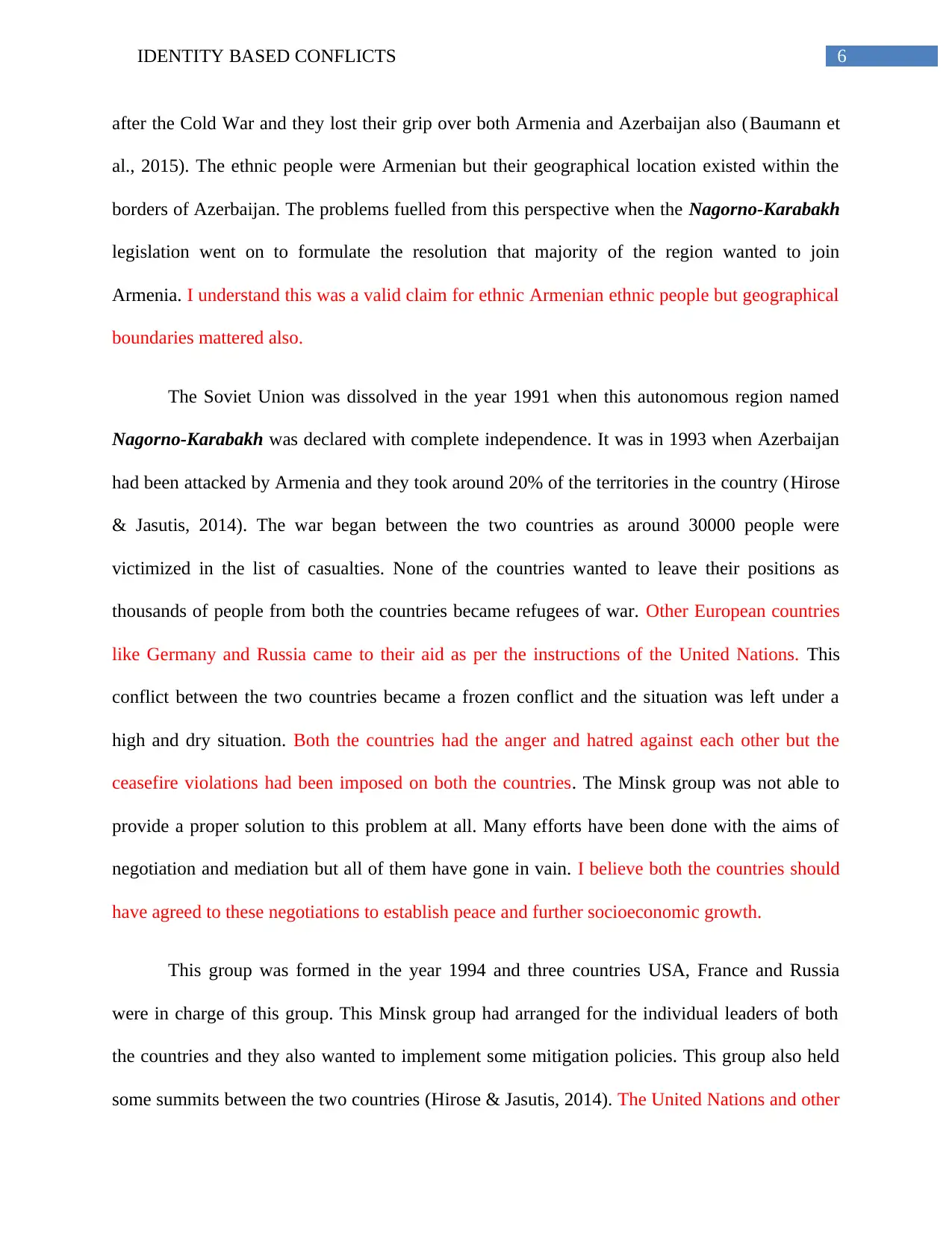
6IDENTITY BASED CONFLICTS
after the Cold War and they lost their grip over both Armenia and Azerbaijan also (Baumann et
al., 2015). The ethnic people were Armenian but their geographical location existed within the
borders of Azerbaijan. The problems fuelled from this perspective when the Nagorno-Karabakh
legislation went on to formulate the resolution that majority of the region wanted to join
Armenia. I understand this was a valid claim for ethnic Armenian ethnic people but geographical
boundaries mattered also.
The Soviet Union was dissolved in the year 1991 when this autonomous region named
Nagorno-Karabakh was declared with complete independence. It was in 1993 when Azerbaijan
had been attacked by Armenia and they took around 20% of the territories in the country (Hirose
& Jasutis, 2014). The war began between the two countries as around 30000 people were
victimized in the list of casualties. None of the countries wanted to leave their positions as
thousands of people from both the countries became refugees of war. Other European countries
like Germany and Russia came to their aid as per the instructions of the United Nations. This
conflict between the two countries became a frozen conflict and the situation was left under a
high and dry situation. Both the countries had the anger and hatred against each other but the
ceasefire violations had been imposed on both the countries. The Minsk group was not able to
provide a proper solution to this problem at all. Many efforts have been done with the aims of
negotiation and mediation but all of them have gone in vain. I believe both the countries should
have agreed to these negotiations to establish peace and further socioeconomic growth.
This group was formed in the year 1994 and three countries USA, France and Russia
were in charge of this group. This Minsk group had arranged for the individual leaders of both
the countries and they also wanted to implement some mitigation policies. This group also held
some summits between the two countries (Hirose & Jasutis, 2014). The United Nations and other
after the Cold War and they lost their grip over both Armenia and Azerbaijan also (Baumann et
al., 2015). The ethnic people were Armenian but their geographical location existed within the
borders of Azerbaijan. The problems fuelled from this perspective when the Nagorno-Karabakh
legislation went on to formulate the resolution that majority of the region wanted to join
Armenia. I understand this was a valid claim for ethnic Armenian ethnic people but geographical
boundaries mattered also.
The Soviet Union was dissolved in the year 1991 when this autonomous region named
Nagorno-Karabakh was declared with complete independence. It was in 1993 when Azerbaijan
had been attacked by Armenia and they took around 20% of the territories in the country (Hirose
& Jasutis, 2014). The war began between the two countries as around 30000 people were
victimized in the list of casualties. None of the countries wanted to leave their positions as
thousands of people from both the countries became refugees of war. Other European countries
like Germany and Russia came to their aid as per the instructions of the United Nations. This
conflict between the two countries became a frozen conflict and the situation was left under a
high and dry situation. Both the countries had the anger and hatred against each other but the
ceasefire violations had been imposed on both the countries. The Minsk group was not able to
provide a proper solution to this problem at all. Many efforts have been done with the aims of
negotiation and mediation but all of them have gone in vain. I believe both the countries should
have agreed to these negotiations to establish peace and further socioeconomic growth.
This group was formed in the year 1994 and three countries USA, France and Russia
were in charge of this group. This Minsk group had arranged for the individual leaders of both
the countries and they also wanted to implement some mitigation policies. This group also held
some summits between the two countries (Hirose & Jasutis, 2014). The United Nations and other
Paraphrase This Document
Need a fresh take? Get an instant paraphrase of this document with our AI Paraphraser
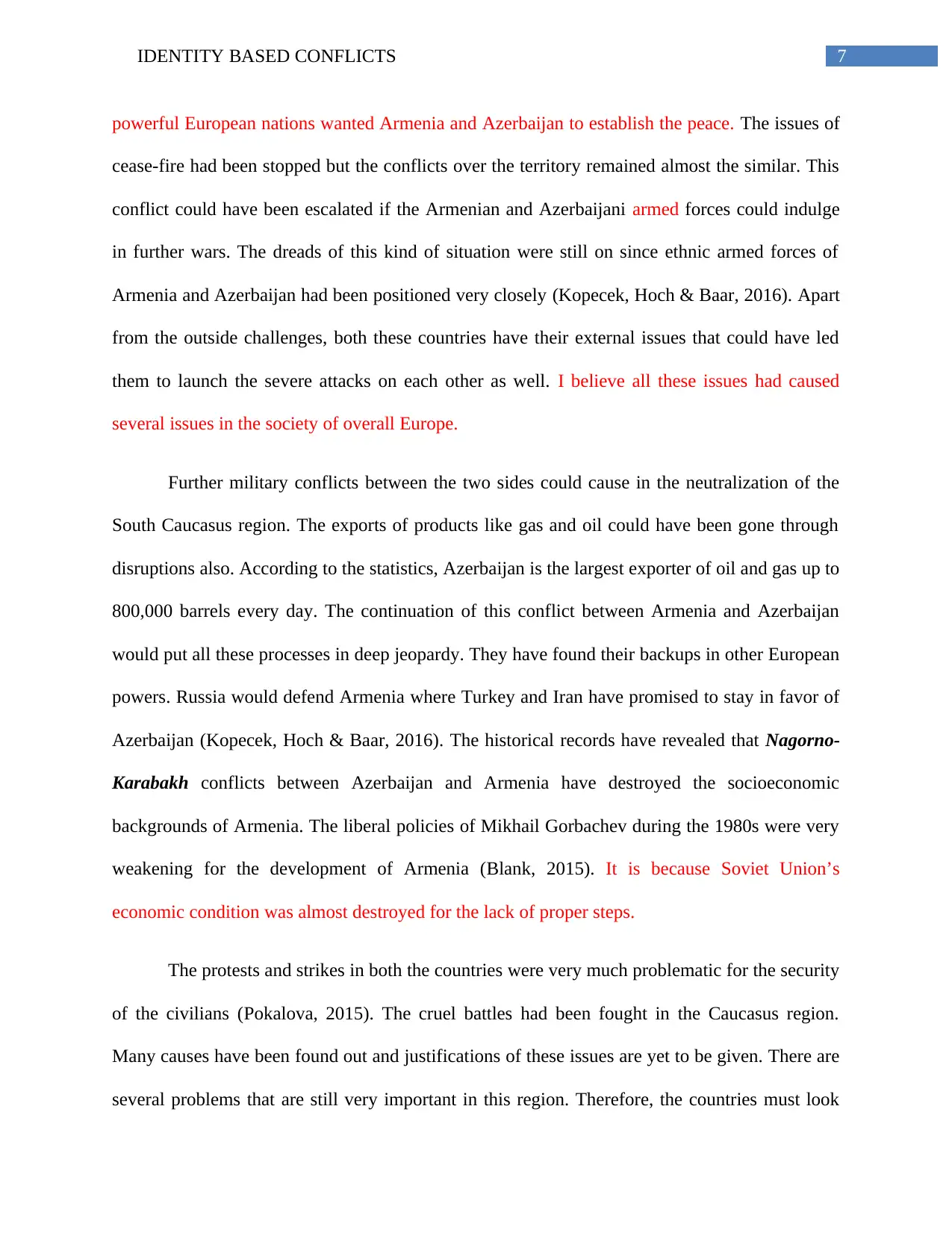
7IDENTITY BASED CONFLICTS
powerful European nations wanted Armenia and Azerbaijan to establish the peace. The issues of
cease-fire had been stopped but the conflicts over the territory remained almost the similar. This
conflict could have been escalated if the Armenian and Azerbaijani armed forces could indulge
in further wars. The dreads of this kind of situation were still on since ethnic armed forces of
Armenia and Azerbaijan had been positioned very closely (Kopecek, Hoch & Baar, 2016). Apart
from the outside challenges, both these countries have their external issues that could have led
them to launch the severe attacks on each other as well. I believe all these issues had caused
several issues in the society of overall Europe.
Further military conflicts between the two sides could cause in the neutralization of the
South Caucasus region. The exports of products like gas and oil could have been gone through
disruptions also. According to the statistics, Azerbaijan is the largest exporter of oil and gas up to
800,000 barrels every day. The continuation of this conflict between Armenia and Azerbaijan
would put all these processes in deep jeopardy. They have found their backups in other European
powers. Russia would defend Armenia where Turkey and Iran have promised to stay in favor of
Azerbaijan (Kopecek, Hoch & Baar, 2016). The historical records have revealed that Nagorno-
Karabakh conflicts between Azerbaijan and Armenia have destroyed the socioeconomic
backgrounds of Armenia. The liberal policies of Mikhail Gorbachev during the 1980s were very
weakening for the development of Armenia (Blank, 2015). It is because Soviet Union’s
economic condition was almost destroyed for the lack of proper steps.
The protests and strikes in both the countries were very much problematic for the security
of the civilians (Pokalova, 2015). The cruel battles had been fought in the Caucasus region.
Many causes have been found out and justifications of these issues are yet to be given. There are
several problems that are still very important in this region. Therefore, the countries must look
powerful European nations wanted Armenia and Azerbaijan to establish the peace. The issues of
cease-fire had been stopped but the conflicts over the territory remained almost the similar. This
conflict could have been escalated if the Armenian and Azerbaijani armed forces could indulge
in further wars. The dreads of this kind of situation were still on since ethnic armed forces of
Armenia and Azerbaijan had been positioned very closely (Kopecek, Hoch & Baar, 2016). Apart
from the outside challenges, both these countries have their external issues that could have led
them to launch the severe attacks on each other as well. I believe all these issues had caused
several issues in the society of overall Europe.
Further military conflicts between the two sides could cause in the neutralization of the
South Caucasus region. The exports of products like gas and oil could have been gone through
disruptions also. According to the statistics, Azerbaijan is the largest exporter of oil and gas up to
800,000 barrels every day. The continuation of this conflict between Armenia and Azerbaijan
would put all these processes in deep jeopardy. They have found their backups in other European
powers. Russia would defend Armenia where Turkey and Iran have promised to stay in favor of
Azerbaijan (Kopecek, Hoch & Baar, 2016). The historical records have revealed that Nagorno-
Karabakh conflicts between Azerbaijan and Armenia have destroyed the socioeconomic
backgrounds of Armenia. The liberal policies of Mikhail Gorbachev during the 1980s were very
weakening for the development of Armenia (Blank, 2015). It is because Soviet Union’s
economic condition was almost destroyed for the lack of proper steps.
The protests and strikes in both the countries were very much problematic for the security
of the civilians (Pokalova, 2015). The cruel battles had been fought in the Caucasus region.
Many causes have been found out and justifications of these issues are yet to be given. There are
several problems that are still very important in this region. Therefore, the countries must look
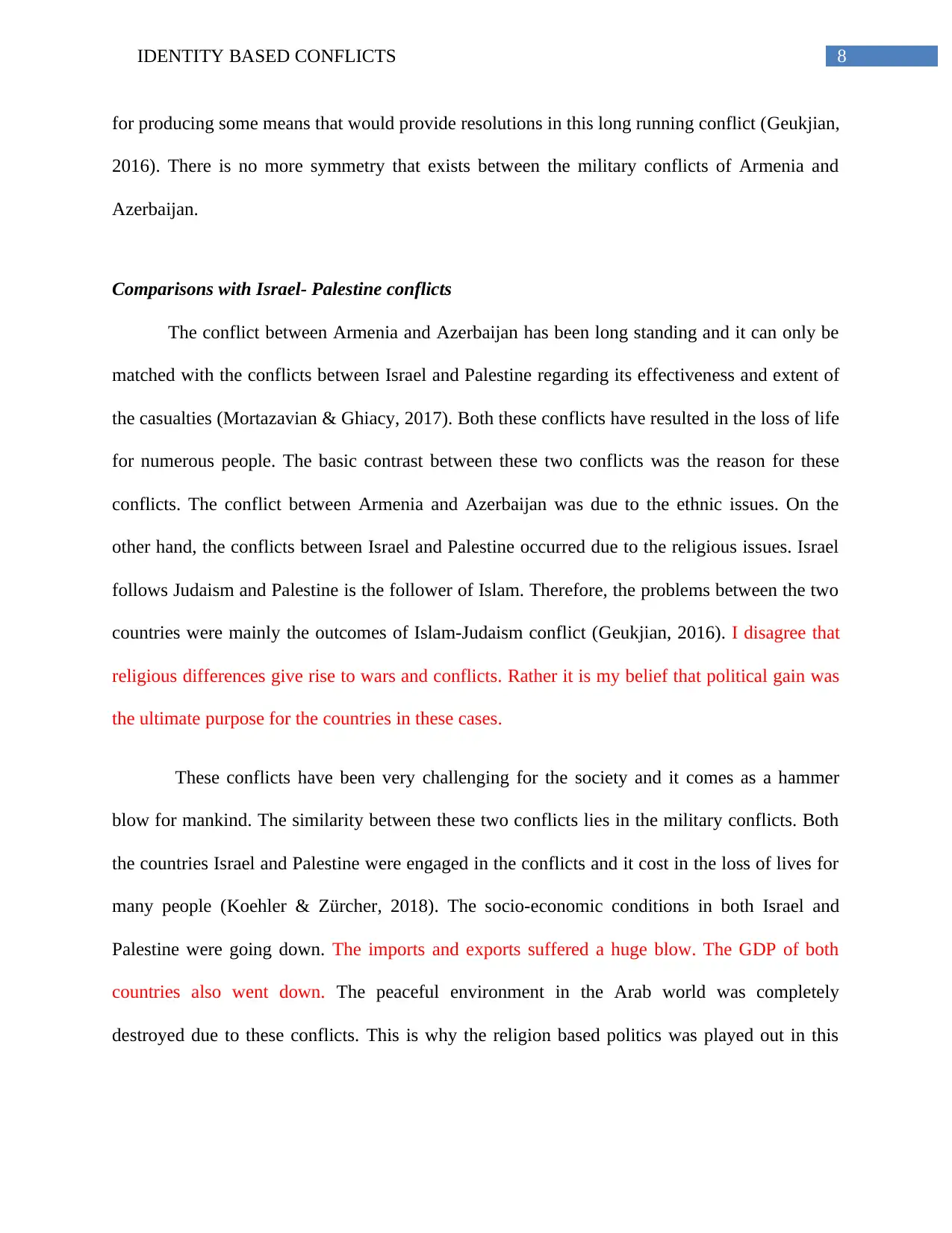
8IDENTITY BASED CONFLICTS
for producing some means that would provide resolutions in this long running conflict (Geukjian,
2016). There is no more symmetry that exists between the military conflicts of Armenia and
Azerbaijan.
Comparisons with Israel- Palestine conflicts
The conflict between Armenia and Azerbaijan has been long standing and it can only be
matched with the conflicts between Israel and Palestine regarding its effectiveness and extent of
the casualties (Mortazavian & Ghiacy, 2017). Both these conflicts have resulted in the loss of life
for numerous people. The basic contrast between these two conflicts was the reason for these
conflicts. The conflict between Armenia and Azerbaijan was due to the ethnic issues. On the
other hand, the conflicts between Israel and Palestine occurred due to the religious issues. Israel
follows Judaism and Palestine is the follower of Islam. Therefore, the problems between the two
countries were mainly the outcomes of Islam-Judaism conflict (Geukjian, 2016). I disagree that
religious differences give rise to wars and conflicts. Rather it is my belief that political gain was
the ultimate purpose for the countries in these cases.
These conflicts have been very challenging for the society and it comes as a hammer
blow for mankind. The similarity between these two conflicts lies in the military conflicts. Both
the countries Israel and Palestine were engaged in the conflicts and it cost in the loss of lives for
many people (Koehler & Zürcher, 2018). The socio-economic conditions in both Israel and
Palestine were going down. The imports and exports suffered a huge blow. The GDP of both
countries also went down. The peaceful environment in the Arab world was completely
destroyed due to these conflicts. This is why the religion based politics was played out in this
for producing some means that would provide resolutions in this long running conflict (Geukjian,
2016). There is no more symmetry that exists between the military conflicts of Armenia and
Azerbaijan.
Comparisons with Israel- Palestine conflicts
The conflict between Armenia and Azerbaijan has been long standing and it can only be
matched with the conflicts between Israel and Palestine regarding its effectiveness and extent of
the casualties (Mortazavian & Ghiacy, 2017). Both these conflicts have resulted in the loss of life
for numerous people. The basic contrast between these two conflicts was the reason for these
conflicts. The conflict between Armenia and Azerbaijan was due to the ethnic issues. On the
other hand, the conflicts between Israel and Palestine occurred due to the religious issues. Israel
follows Judaism and Palestine is the follower of Islam. Therefore, the problems between the two
countries were mainly the outcomes of Islam-Judaism conflict (Geukjian, 2016). I disagree that
religious differences give rise to wars and conflicts. Rather it is my belief that political gain was
the ultimate purpose for the countries in these cases.
These conflicts have been very challenging for the society and it comes as a hammer
blow for mankind. The similarity between these two conflicts lies in the military conflicts. Both
the countries Israel and Palestine were engaged in the conflicts and it cost in the loss of lives for
many people (Koehler & Zürcher, 2018). The socio-economic conditions in both Israel and
Palestine were going down. The imports and exports suffered a huge blow. The GDP of both
countries also went down. The peaceful environment in the Arab world was completely
destroyed due to these conflicts. This is why the religion based politics was played out in this
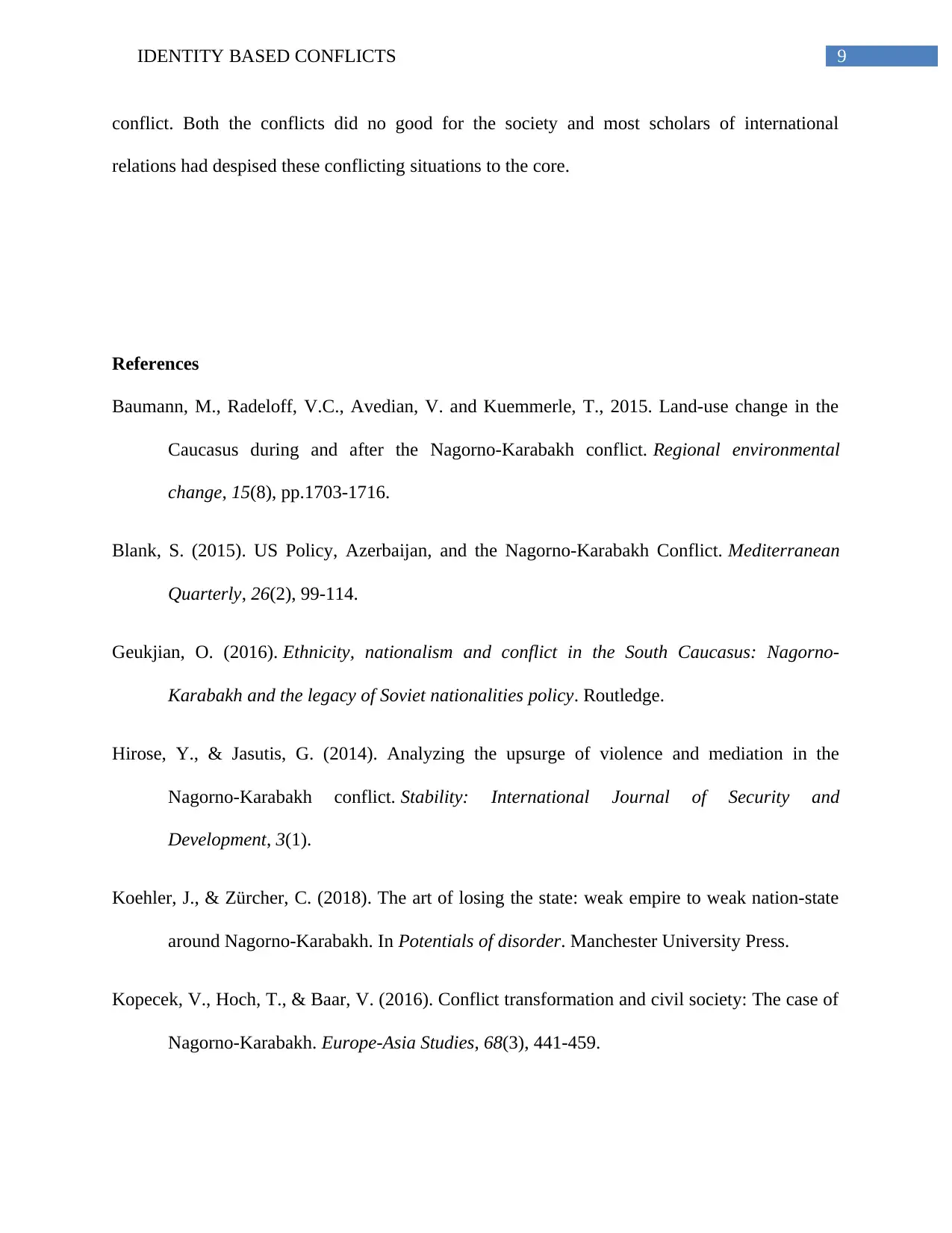
9IDENTITY BASED CONFLICTS
conflict. Both the conflicts did no good for the society and most scholars of international
relations had despised these conflicting situations to the core.
References
Baumann, M., Radeloff, V.C., Avedian, V. and Kuemmerle, T., 2015. Land-use change in the
Caucasus during and after the Nagorno-Karabakh conflict. Regional environmental
change, 15(8), pp.1703-1716.
Blank, S. (2015). US Policy, Azerbaijan, and the Nagorno-Karabakh Conflict. Mediterranean
Quarterly, 26(2), 99-114.
Geukjian, O. (2016). Ethnicity, nationalism and conflict in the South Caucasus: Nagorno-
Karabakh and the legacy of Soviet nationalities policy. Routledge.
Hirose, Y., & Jasutis, G. (2014). Analyzing the upsurge of violence and mediation in the
Nagorno-Karabakh conflict. Stability: International Journal of Security and
Development, 3(1).
Koehler, J., & Zürcher, C. (2018). The art of losing the state: weak empire to weak nation-state
around Nagorno-Karabakh. In Potentials of disorder. Manchester University Press.
Kopecek, V., Hoch, T., & Baar, V. (2016). Conflict transformation and civil society: The case of
Nagorno-Karabakh. Europe-Asia Studies, 68(3), 441-459.
conflict. Both the conflicts did no good for the society and most scholars of international
relations had despised these conflicting situations to the core.
References
Baumann, M., Radeloff, V.C., Avedian, V. and Kuemmerle, T., 2015. Land-use change in the
Caucasus during and after the Nagorno-Karabakh conflict. Regional environmental
change, 15(8), pp.1703-1716.
Blank, S. (2015). US Policy, Azerbaijan, and the Nagorno-Karabakh Conflict. Mediterranean
Quarterly, 26(2), 99-114.
Geukjian, O. (2016). Ethnicity, nationalism and conflict in the South Caucasus: Nagorno-
Karabakh and the legacy of Soviet nationalities policy. Routledge.
Hirose, Y., & Jasutis, G. (2014). Analyzing the upsurge of violence and mediation in the
Nagorno-Karabakh conflict. Stability: International Journal of Security and
Development, 3(1).
Koehler, J., & Zürcher, C. (2018). The art of losing the state: weak empire to weak nation-state
around Nagorno-Karabakh. In Potentials of disorder. Manchester University Press.
Kopecek, V., Hoch, T., & Baar, V. (2016). Conflict transformation and civil society: The case of
Nagorno-Karabakh. Europe-Asia Studies, 68(3), 441-459.
Secure Best Marks with AI Grader
Need help grading? Try our AI Grader for instant feedback on your assignments.
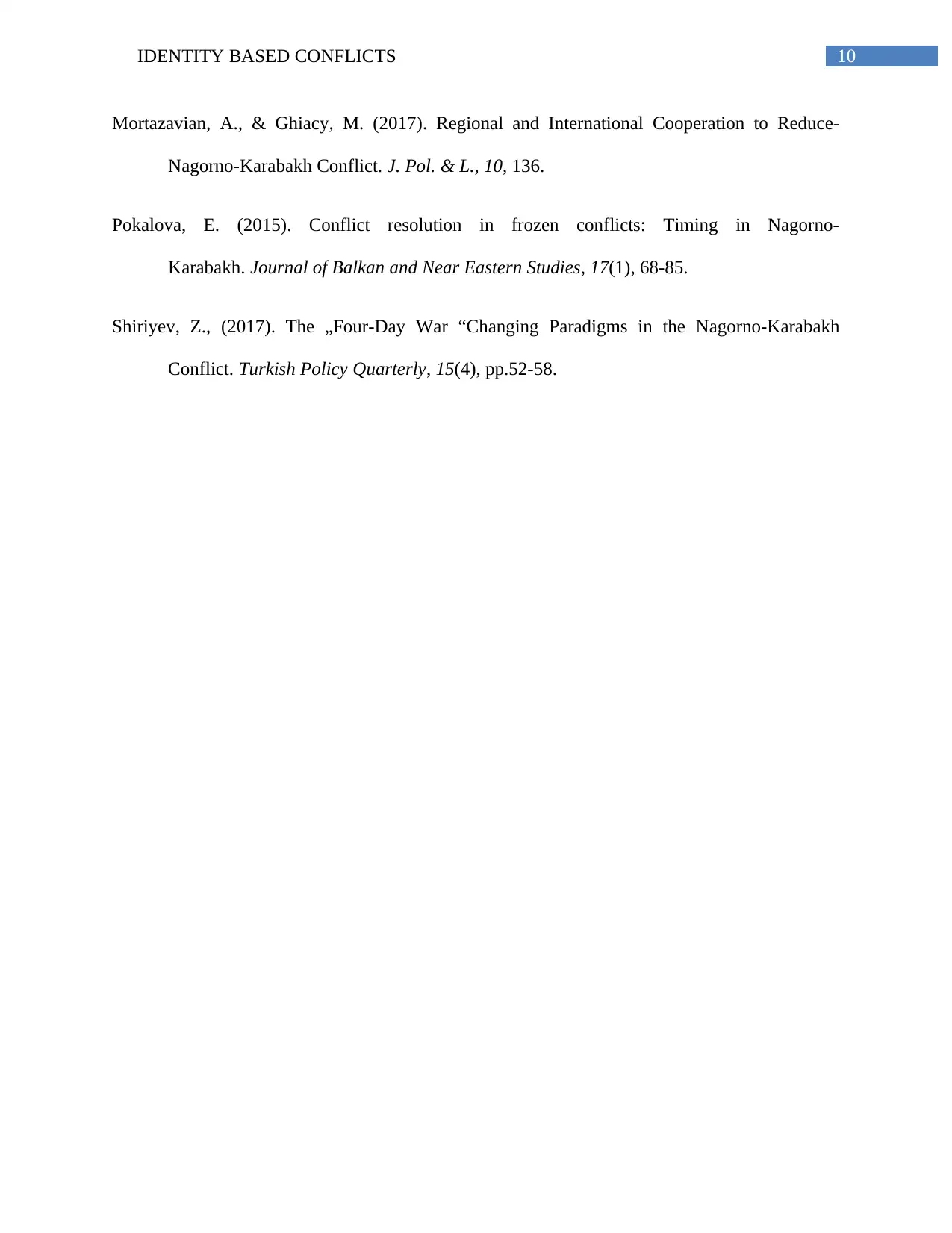
10IDENTITY BASED CONFLICTS
Mortazavian, A., & Ghiacy, M. (2017). Regional and International Cooperation to Reduce-
Nagorno-Karabakh Conflict. J. Pol. & L., 10, 136.
Pokalova, E. (2015). Conflict resolution in frozen conflicts: Timing in Nagorno-
Karabakh. Journal of Balkan and Near Eastern Studies, 17(1), 68-85.
Shiriyev, Z., (2017). The „Four-Day War “Changing Paradigms in the Nagorno-Karabakh
Conflict. Turkish Policy Quarterly, 15(4), pp.52-58.
Mortazavian, A., & Ghiacy, M. (2017). Regional and International Cooperation to Reduce-
Nagorno-Karabakh Conflict. J. Pol. & L., 10, 136.
Pokalova, E. (2015). Conflict resolution in frozen conflicts: Timing in Nagorno-
Karabakh. Journal of Balkan and Near Eastern Studies, 17(1), 68-85.
Shiriyev, Z., (2017). The „Four-Day War “Changing Paradigms in the Nagorno-Karabakh
Conflict. Turkish Policy Quarterly, 15(4), pp.52-58.
1 out of 11
Your All-in-One AI-Powered Toolkit for Academic Success.
+13062052269
info@desklib.com
Available 24*7 on WhatsApp / Email
![[object Object]](/_next/static/media/star-bottom.7253800d.svg)
Unlock your academic potential
© 2024 | Zucol Services PVT LTD | All rights reserved.



